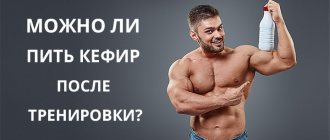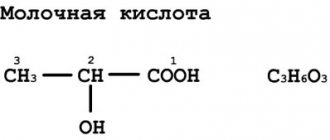Often a person is worried about pain in the muscles of the arms. It can appear after an injury, physical stress, or arise as a complication of some internal disease. The hand is moved by a large number of muscles, especially in the wrist. All of them are equipped with blood and lymphatic vessels, as well as nerves. Muscles are attached to bones and articular surfaces. Therefore, painful sensations can be associated with malfunctions in any system of the body.
What kind of pain are there?
Pain in the arm muscles is called myalgia. It can be an independent symptom or one of the signs of various diseases. Such pain is usually detected by palpation or movement. But it can also be permanent. For example, with inflammatory diseases of the arm muscles, aching pain appears. It can be expressed in a general unpleasant sensation spread throughout the arm. This condition also often indicates osteochondrosis or periarthritis.
In case of injury, infection or pinched nerve, acute pain occurs. Many people describe such sensations as cutting, shooting or dagger-like. They can also appear during a heart attack.
With myalgia, pain may occur in certain muscle groups, for example, the shoulder girdle or fingers. Or the pain spreads throughout the arm, sometimes without a clear localization.
Often the cause of pain is injury or excessive stress during sports.
Hand injuries
When the ligaments of the wrist joint are damaged, first a sharp pain is felt, then a pulling pain, it becomes painful to move the hand, and movements are limited.
When a phalanx of a finger is dislocated, swelling appears at the site of injury, and this part becomes deformed. But dislocation of the lunate, scaphoid, pisiform and other small bones affects the function of the hand and is difficult to recognize. If there is a fracture of the hand, movements are sharply limited, the site of injury swells, the hand may move pathologically, and the crunching of fragments can be heard. A plaster cast or orthosis is used to fix the fracture. Usually the doctor prescribes physiotherapy with massage and physical therapy. Sometimes surgery is performed to restore the normal structure of the hand.
Causes of pain
Pain occurs due to the development of an inflammatory process, swelling or impaired permeability of cell membranes. Their appearance is also caused by microtrauma of muscle fibers, accumulation of lactic acid in tissues, disruption of muscle nutrition and metabolic processes in cells. The reasons for this condition are very different:
- Most often, painful sensations appear due to injury: sprains, bruises, joint dislocations, bone fractures;
- Recently, a common cause of pain in the muscles of the right hand is working on a computer: prolonged forced positioning of the hand leads to impaired blood circulation and pinched nerves;
- strong physical stress, increased load on the hands during sports training or other activities leads to micro-tears of the fibers or the accumulation of lactic acid;
- a lack of enzymes necessary for normal muscle function can be caused by poor circulation;
- Women often experience nagging pain in the shoulder girdle due to stress, overwork or lack of sleep; this phenomenon is called fibromyalgia;
- intoxication of the body, for example, alcohol or carbon monoxide poisoning, often causes pain in the muscles due to the accumulation of toxins in the tissues.
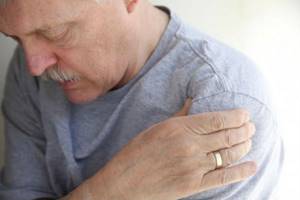
Muscle pain can appear due to various diseases, for example, osteochondrosis, neuralgia or atherosclerosis
Why does my hand hurt when I exercise?
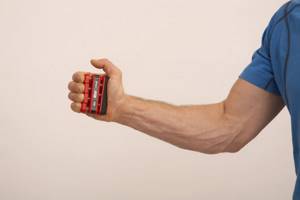
The hands can also become sore during physical activity. And the reasons for this are:
- osteoarthritis
- tendinitis
- untreated old injuries and injuries in the wrist area
Osteoarthritis weakens the cartilage of the joints and wrist bone. It may also develop due to:
- poorly treated fractures of the hand and fingers
- the presence of a systemic chronic disease, for example, polyarthritis
- disruptions in the body's metabolic processes

In addition to pain, you may hear a crunching sound, see swelling in the area of the affected joint, and in advanced cases, its deformation. You have great difficulty in handling small objects because your hands and fingers refuse to bend and straighten properly.
Tendinitis is localized in the inflamed tendons of the wrist. This disease is of an occupational nature and occurs in athletes, seamstresses, pianists, and loaders.
Tendinitis manifests itself as acute pain and weakness of the arms during exercise on the hands.
You may also hear crunching sounds when you work with your hands.
It is treatable, but returns again when the person resumes his usual activities.
The third cause of pain symptoms in the hands during exercise is untreated injuries. For example, a fracture of the phalanx of a finger, without proper treatment, heals incorrectly and can no longer perform its functions efficiently. The same applies to fractures, cracks and displacements of bones in the wrist area.
Diseases that cause pain in the hands
Such sensations may indicate the development of inflammatory or infectious diseases, diseases of the musculoskeletal system, cardiovascular system, or metabolic disorders. Most often they are associated with pathological processes in the muscle itself, but not always. Hand pain is a symptom of the following diseases:
Also read:
Pain in muscles and joints
- myositis – muscle inflammation due to hypothermia;
- some parasites, for example, toxoplasma, live in muscle fibers, causing very severe pain, this is the so-called parasitic myositis;
- polymyalgia rheumatica begins with pain and tension in the neck and shoulder girdle;
- general infectious and inflammatory diseases - influenza, ARVI, brucellosis;
- diffuse myalgia develops due to muscle damage by the virus;
- osteomyelitis causes destruction of bone tissue, which leads to muscle inflammation;
- herniated discs, osteochondrosis or sciatica can cause pain in the shoulder girdle;
- neuralgia occurs due to nerve damage;
- carpal tunnel syndrome causes severe pain in the forearm and hand and occurs with prolonged exercise;
- deterioration of vascular patency – atherosclerosis, thrombosis;
- diseases of bone and cartilage tissue: tendonitis, fasciitis, synovitis;
- cramps - involuntary muscle contractions;
- often severe heart pain, for example, during a heart attack, radiates to the arm;
- diabetes can also cause muscle pain.
Who to contact and how to treat?
When unpleasant sensations occur in the hand, a person wonders what to do in such a situation, why the problem arose, and how to fix it. First of all, you need to visit the clinic. In case of traumatic etiology, contact a traumatologist. If the pain is joint, then go to an orthopedist. If the cause of the syndromes is unclear, contact a therapist, who will refer you for tests and write a referral to a specialist.
If the pain is due to chronic injuries or sprains, it is relieved symptomatically along with swelling, developing the fingers to prevent contracture.
In case of chronic injury, the work schedule is changed and the workplace is re-equipped. So, with carpal tunnel syndrome, you need to use mouse pads with a bolster to support your hand, massage the damaged area and take periodic breaks.
Taking medications
NSAIDs are used as anti-inflammatory drugs. Injections and tablets have a negative effect on the stomach, so they are used if ointments and gels do not help. Inflamed areas can be anointed with the following preparations:
- Diclofenac;
- Nise;
- Finalgel;
- Flexen;
- Fastum;
- Dolgit;
- Nurofen.
Ointment, tablets and injections generally have the same trade names.
Injections are used to relieve acute pain.
With a long course of medication (more than 3 days - injections and 10 days - tablets), the doctor prescribes drugs that protect the gastrointestinal tract from the side effects of NSAIDs: Ranitidine, Almagel, etc.
To treat diseases affecting ligaments and joints, chondroprotectors containing glucosamine and chondroitin sulfate are used:
- Teraflex;
- Don;
- Chondrolone.
Muscle pain and spasms are relieved with muscle relaxants:
- Sirdalud;
- Baclofen;
- Mydocalm.
To reduce pain, B vitamins are prescribed.
For tenosynovitis, bursitis, infectious arthritis, ruptures of large ligaments and fractures, operations are performed.
Sometimes the medicine is administered directly into the diseased joint using injections.
Acute pain is relieved with hormonal drugs: Hydrocortisone, Kenalog.
Mobility is improved with hyaluronic acid: Fermathron, Synvisc.
To relieve the symptoms of gout and arthritis, use an infusion of walnut shells, lilac flowers, and dandelion roots.
Reduce the intensity of inflammatory processes, relieve pain and warm up joints using a compress of vodka and honey.
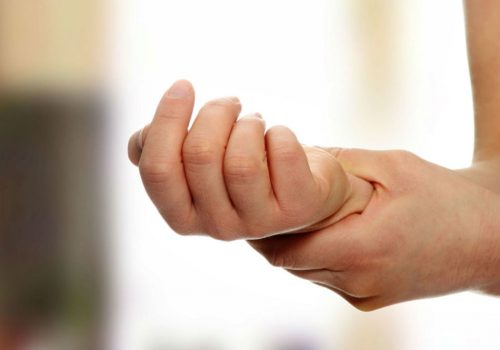
To relieve pain, swelling and tension, add herbs and essential oils of lilac, nettle, rosemary, and viburnum to warm baths.
When to see a doctor
If the causes of the pain are clear, and after eliminating them the pain was relieved, then there is nothing to worry about. This usually happens after overexertion or increased load during training. Such pain in the arm muscles goes away after rest. But sometimes you need to see a doctor:
- if home treatment does not help, the pain lasts longer than 3-5 days;
- when the temperature rises and the general condition of the body worsens;
- if severe pain prevents you from moving your arm;
- when the muscle swells and the skin over it turns red.
Medical care is needed because if not treated correctly, complications may develop. This may be improper fusion of muscle fibers if the pain is due to injury, poor circulation and muscle atrophy, as well as limited arm mobility and decreased performance.
Why does my child's hand hurt?

Children move and play a lot, so they are not immune from bruises and injuries. Poor movements, heavy lifting and monotonous long-term activities for the hands, such as drawing and playing the piano, cause pain in the hands.
On the other hand, take into account such factors as heredity. If one of the parents was diagnosed with osteoarthritis, then this disease can manifest itself in the child.
The cause of osteoarthritis is arthrosis, or in other words, too rapid aging and destruction of cartilage tissue in the joints.
The child complains about:
- hand pain even when pressing on the joint area of the wrist
- limited mobility
What to do if your arm muscles hurt
In most cases, home treatment for arm muscle pain is possible. If they arise due to increased physical activity, you can help yourself in the following ways:
- limit the movement of the injured arm using an elastic bandage or a special orthosis;
- take a tablet of a non-steroidal anti-inflammatory or pain reliever;
- during muscle recovery after exercise, you need to drink more water;
- In case of a cramp, you need to relax the limb and give a light soothing massage.
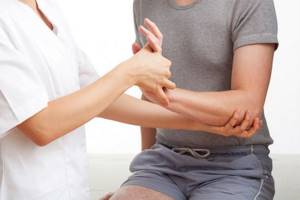
If the pain does not go away for several days, you need to be examined by a doctor.
Pain due to inflammatory or infectious diseases can be relieved only by eliminating their cause. Treatment should be carried out by a doctor after examination and diagnosis.
How to properly stretch your arms after a workout
During exercise, the muscles in your arms contract. After training, they should return to their original length, but this will take several days. To help you recover faster, stretch after every workout.
Execution rules:
- The duration should not be less than five minutes. Ideally - from fifteen to twenty. And once a week we recommend stretching for at least half an hour.
- After heavy exercise, be sure to get your heart rate back up before you start stretching your muscles. You can drink water and walk around for a couple of minutes.
- Stretching after training must be static - no sudden or springy movements. It should also be aimed at the entire body, not just the muscles you just worked.
- Watch your breathing: take a deep breath and then exhale slowly. This will set you up for relaxation.
- You should not do stretching aimed at increasing flexibility. Your task is to help the contracted muscles recover. Don't overdo it to avoid damaging tense joints.
- When bending towards your feet, do not round your back, even if you lack the dexterity. Keep it straight to avoid damaging your spine.
- You can add a massage roller to the stretching; this will replace self-massage.
- Remember that there should be no pain! The exercises should be performed until there is slight discomfort, after which you will feel pleasant relaxation.
Treatment of pain in arm muscles
If the pain does not go away, it is better to get examined by a doctor to determine the cause of this condition. Accordingly, treatment for myalgia will be prescribed. The most commonly used methods are:
- take painkillers and non-steroidal anti-inflammatory drugs - Aspirin, Ibuprofen, Metindol, Ketoprofen and others;
- after an injury, you need to use a cooling ointment containing NSAIDs to relieve pain and prevent inflammation: Diclofenac, Indomethacin, Voltaren, Fatum Gel and others;
- for neuralgia, myositis and pain due to joint diseases, it is better to use ointments with a warming effect: “Nise”, “Finalgon”, “Viprosal”, “Apizartron”;
- for cramps, muscle relaxants are used to relax muscles, for example, Mydocalm or Milgamma;
- if the pain is caused by circulatory disorders, you can use vasodilators orally (Stugeron, Drotaverin) or ointments Troxevasin, Traumeel;
- Massage, acupuncture, physical therapy are very effective;
- Physiotherapy helps to cope with painful sensations: electrophoresis, laser, paraffin treatment;
- As an auxiliary treatment for any muscle pain, folk remedies are used: compresses with vinegar or vodka, applying cabbage leaves or boiled potatoes, rubbing the muscles with tincture of hot pepper, St. John's wort or lilac flowers, ointment based on chamomile and butter.
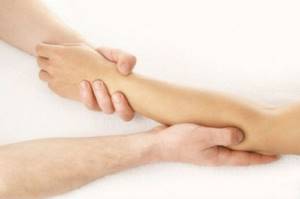
Massage relaxes muscles well and relieves pain
Possible complications
Consequences appear in the absence of pain therapy. Over time, it begins to increase its intensity, eventually disturbing the person even at rest. Necrosis may then develop.
And if an additional symptom indicates a disease, the pathological process worsens. As a result, the tissue can be completely destroyed. In this case, the mobility of the hand is restored only with the help of a prosthesis.
Complications also arise when injured. When blood vessels are destroyed, there is a high probability of blood loss. If the fracture is open, infection is immediate. Discomfort in the wrist may indicate a disease (arthritis, carpal tunnel syndrome, etc.), indicate an injury (sprain, fracture) or physiological reasons (overexertion, hormone production).
Before treating pain, it is necessary to conduct a complete examination of the body. Therapy consists of the use of medications, folk remedies and other methods (surgery, physiotherapy, therapeutic exercises). The most important thing is to visit a doctor on time to avoid complications.
Article design: Vladimir the Great
The best ointments for muscle pain
The simplest and most common way to get rid of such sensations is to use external agents in the form of an ointment or gel. They are convenient to use and the effect appears quickly. But it must be remembered that the ointment only relieves symptoms, in addition, there are drugs that have different effects on the muscles. To know which ointment to choose, you need to determine the cause of the pain. The most effective drugs are:
- “Viprosal” contains snake venom, camphor and fir oil, has a warming and distracting effect;
- “Capsicam” is an ointment for muscle pain based on dimexide, camphor and turpentine;
- “Finalgon” improves blood circulation and has a warming effect;
- “Dolobene” relieves inflammation, improves blood circulation and promotes tissue regeneration;
- “Apizartron”, thanks to the presence of bee venom and methyl salicylate, warms and relaxes muscles, relieves inflammation;
- "Nkoflex" has a vasodilating, analgesic and warming effect;
- "Traumel" is a homeopathic remedy that quickly relieves pain and swelling, stops bleeding, increases the body's defenses and is involved in tissue regeneration.

There are various ointments that help relieve inflammation and swelling, as well as reduce pain.
It is very unpleasant when your hands hurt. This prevents a person from leading a normal life; often severe pain prevents him from even serving himself. Therefore, you need to try to prevent this condition: do not overcool, dose the load during training, treat infectious and chronic diseases in a timely manner. It is not advisable to relieve severe pain on your own; it is better to consult a doctor to prescribe the correct treatment. Then you can quickly regain your ability to work and prevent the development of complications.
Joint killer exercises
Let's look at what exercises can lead to joint pain and other dangerous consequences.
Single leg squats
This exercise is very powerful and effective. During its execution, a huge part of the muscular system is involved. These squats can be compared to squats with a barbell. The danger of doing it is that if done incorrectly or if the load is distributed incorrectly, too much compression occurs on:
- spine;
- intervertebral discs;
- cartilage;
- joints.
People who suffer from any diseases of the musculoskeletal system are not recommended to perform this exercise. The knee joint experiences the greatest load during this exercise. If there are any violations in its work, you should not perform such a squat.
Reverse push-ups
An exercise in which a person pushes up face up, resting on his arms laid back, is dangerous. Shoulders and elbows are in an unnatural position and are under severe stress. With this exercise, sprains of ligaments and muscles, dislocations, and microcracks in bone structures may occur.
Bench press
Extremely dangerous exercises are lifting and placing hands with weights, barbells or dumbbells behind the head. Such training carries the risk of injuries to the lower back, shoulders and elbows. In order to train your muscles, you can do safer push-ups.
Plyometrics
This is a trend in fitness that involves sudden jumps, raising your arms to the side, and push-ups. This is an anaerobic exercise that is not suitable for everyone. When training, there is a serious load on the joints, especially on the knees and ankles.
If such exercises are chosen incorrectly, this will negatively affect the functions of the cardiac apparatus. The risk of injury from an unsuccessful landing or even a fall also increases. In addition, this is a very high load on the spine.
Lunges with a barbell
This exercise is very popular in gyms. Many people believe that bending over with a barbell or dumbbells trains the corset of the back, abs and hips. Such movements carry serious danger. This is a big overload, especially if the bends are too active or the weight is too heavy. This is fraught with injury to the spinal column and back muscles.
